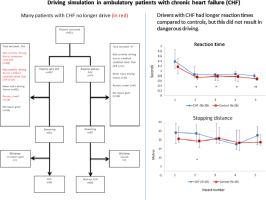Journal of cardiac failure ( IF 6.7 ) Pub Date : 2020-05-18 , DOI: 10.1016/j.cardfail.2020.04.002 Daniel Pan 1 , Pierpaolo Pellicori 2 , Claire Walklett 3 , Andrew Green 4 , Anais R Masse 4 , Jason Wood 4 , Jon Purdy 4 , Andrew L Clark 3

|
Background
Judgement and reaction times during complex tasks like driving may be impaired in older adults with chronic heart failure (HF). This study sought to report the driving habits and reaction times of older patients with HF in a specially designed urban driving simulation.
Methods and Results
We conducted a prospective observational study in HF patients and controls. Patients in both groups underwent cognitive testing and screening for depression. Current drivers undertook a questionnaire regarding driving habits followed by an urban road driving simulation consisting of 3 laps. Five separate hazards appeared in the third lap without warning. Reaction times and stopping distances to the hazards were calculated. Of 247 patients with HF approached for the study, 124 had already voluntarily stopped driving owing to HF (n = 92) or other medical conditions (n = 32), 60 had never had a license, and 32 declined to participate. Of the 74 controls approached, 1 was not currently driving owing to a medical condition and 46 declined to participate. Patients in both groups had similar levels of cognitive function, mood and driving habits. 30 patients with HF (mean age, 74 ± 5 years; median NT-proBNP 1510 pg/mL [interquartile range (IQR), 546–3084 pg/L]) and 26 controls (mean age, 73 ± 5 years; median NT-proBNP 135 pg/mL [IQR, 73–182 pg/L]) completed the simulation. During lap 3, there was no difference in the driving speed between patients (mean 22.0 ± 4.5 mph) and controls (mean 21.7 ± 3.3 mph; P = .80). Patients had longer reaction times (median, 1.10 seconds; IQR, 0.98–1.30 seconds) than controls (median, 0.96 seconds; IQR, 0.83–1.10 seconds; P = .02), but there was no difference in stopping distances (patients: median, 43.9 m [IQR, 32.2–49.5 m]; controls: median, 38.1 m [IQR, 32.3-48.8 m]; P = .31).
Conclusions
Many older adults with HF no longer drive. Those who continue to drive seem to be safe to drive on simulated urban roads.
中文翻译:

对患有慢性心力衰竭的老年驾驶员进行驾驶模拟的驾驶习惯和反应时间。
背景
患有慢性心力衰竭 (HF) 的老年人在驾驶等复杂任务期间的判断力和反应时间可能会受损。本研究试图在专门设计的城市驾驶模拟中报告老年 HF 患者的驾驶习惯和反应时间。
方法和结果
我们在 HF 患者和对照组中进行了一项前瞻性观察研究。两组患者均接受了认知测试和抑郁症筛查。目前的驾驶员进行了有关驾驶习惯的问卷调查,然后进行了由 3 圈组成的城市道路驾驶模拟。第三圈出现了五个独立的危险,没有任何警告。计算了对危害的反应时间和停止距离。在接受研究的 247 名 HF 患者中,124 名已经由于 HF ( n = 92) 或其他医疗条件 ( n = 32),60 人从未获得过执照,32 人拒绝参加。在接近的 74 名控制者中,1 人目前因健康状况未开车,46 人拒绝参与。两组患者的认知功能、情绪和驾驶习惯水平相似。30 名 HF 患者(平均年龄,74 ± 5 岁;中值 NT-proBNP 1510 pg/mL [四分位距 (IQR),546–3084 pg/L])和 26 名对照者(平均年龄,73 ± 5 岁;中值 NT -proBNP 135 pg/mL [IQR, 73–182 pg/L]) 完成了模拟。在第 3 圈,患者(平均 22.0 ± 4.5 mph)和对照组(平均 21.7 ± 3.3 mph;P = .80)之间的驾驶速度没有差异。患者的反应时间(中位数,1.10 秒;IQR,0.98-1.30 秒)比对照组(中位数,0.96 秒;IQR,0.83-1.10 秒;P = .02),但停止距离没有差异(患者:中位数,43.9 m [IQR,32.2-49.5 m];对照:中位数,38.1 m [IQR,32.3-48.8 m];P = .31)。
结论
许多患有 HF 的老年人不再开车。那些继续开车的人在模拟的城市道路上开车似乎是安全的。











































 京公网安备 11010802027423号
京公网安备 11010802027423号